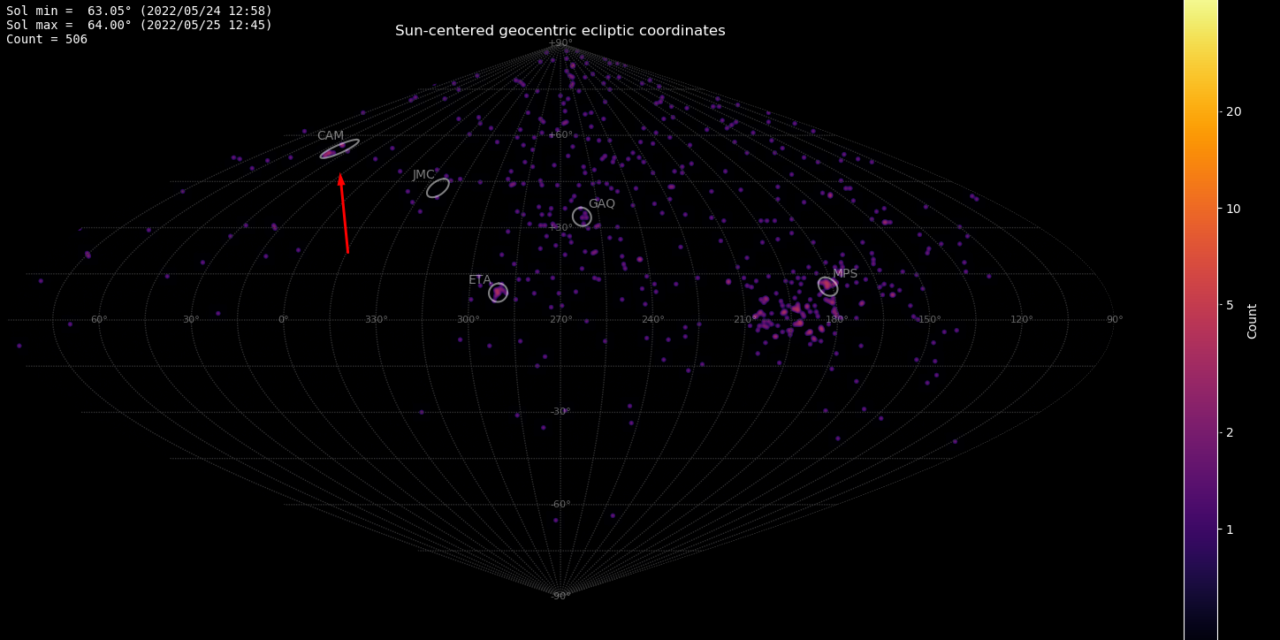By Damir Šegon, Denis Vida and Paul Roggemans
Abstract: Seven very similar Camelopardalid orbits were collected by cameras of the Global Meteor Network in a time span of less than 7 hours around solar longitude 63.56° (2022 May 25, 01h48m UT). More dispersed orbits related to this meteor shower have been recorded during the entire month of May 2022. It is not yet clear if the short interval with a slight increase in number of orbits is due to an unknown dust trail related to comet 209P/LINEAR.
Introduction
The Camelopardalids are a recent discovered meteor shower associated with comet 209P/LINEAR, formerly known as 2004 CB, which was discovered on February 3rd 2004 by Lincoln Near-Earth Asteroid Research. Comet 209P/LINEAR is a weakly active Jupiter Family comet with an orbital period of 5.02 years. The close approach of the comet’s orbit to the orbit of the Earth inspired some researchers to check for possible meteor activity. The models suggested enhanced meteor activity on May 24th, 2014. The first modeler to predict meteor activity produced by dust from this comet was Esko Lyytinen, whose predictions were included in a book by Jenniskens (Table 6j, page 689, Jenniskens, 2006). Later this prediction was recalled in a CBET, Central Bureau Electronic Telegrams, by Jenniskens and Lyytinen (2014). The forecast was also studied by Ye and Wiegert (2014).
A Polish team of meteor observers organized an observing expedition to Canada following the outlook for a possible Camelopardalid outburst (Wiśniewski et al., 2015). The unpredictable nature of meteoroid streams once again confirmed its reputation. The Earth crossed the stream of meteoroids at the time it was expected but the activity level of the outburst was much lower than expected which greatly reduced the number of registered meteor trajectories and calculated orbits. Observations of the Camelopardalid meteor shower in May 2014 were obtained with six different sets of cameras near two different geographical locations; Alabama, USA, and Ontario, Canada (Campbell-Brown et al., 2016) The calculated flux and the corresponding Zenithal Hourly Rate of 20 was in good agreement with the results of Toth et al. (2015) and Jenniskens (2014). Madiedo et al. (2014) obtained coordinates for the geocentric radiant from the analysis of seven Camelopardalids as αg = 121.9 ± 1.1°, δg = 78.3 ± 0.4° recorded during the main activity period, The averaged geocentric velocity calculated for these meteors was vg = 16.4 ± 0.6 km/s agreed with the predicted values and results published by other researchers (Jenniskens, 2014). The tensile strength of the Camelopardalids compares well with other fragile meteoroids of cometary origin, such as the Orionids and the Leonids. This conclusion is similar to that of Campbell-Brown et al. (2016). The spectral data obtained for the Camelopardalids suggests non-chondritic meteoroids with a low abundance of Fe with respect to the chondritic value (Madiedo et al., 2014). Jenniskens (2014) found that approximately half of the Camelopardalids had higher beginning heights than typical for meteors of the same speed, and half began lower than typical. This could indicate that half were more fragile than average meteors and half stronger. Many of the light curves showed early or symmetric light curves, which are associated with fragmenting meteoroids. Light curves were U-shaped, with peak luminosity at 88 km altitude.
The Camelopardalid shower appeared in earlier stream searches. A search in 2013 for meteor orbits matching comets and NEO orbits revealed 23 orbits similar to the orbit of 209P/LINEAR, active between April 24 and June 4. This shower was added to the IAU MDC database as the May λ Draconids (MLD #0532) (Šegon et al., 2014). When the shower entry CAM #0451 in the IAU MDC database was updated, it was obvious that the new entry was a duplication of the until then poorly documented Camelopardalids (CAM #0451).
Camelopardalid orbits were identified among 2007–2009 SonotaCo and 2010–2011 CAMS orbit data (Rudawska and Jenniskens, 2014). Eight Camelopardalid orbits were identified between April 22 and May 6 that fulfilled the orbit similarity criterion of Southworth and Hawkins (1963) with DSH < 0.05. Another search among 83369 EDMOND meteor orbits collected until 2012 revealed another four Camelopardalid orbits (Kornoš et al., 2014). A new stream search on the 2010–2013 CAMS data resulted in 19 Camelopardalid orbits (Jenniskens and Nénon, 2016).
In more recent years the Global Meteor Network identified each year a number of Camelopardalid orbits, 4 in 2019, 1 in 2020 and 2 in 2021 (Roggemans et al., 2022). Three Camelopardalids were recorded in a ~4-hour window, from 04h45m to 09h00m UTC on 2019 May 24, around the time of a low activity outburst at 7h44m UT on 24 May 2019 predicted by Mikhail Maslov (Vida and Eschman, 2020). More shower members would be identified if the shower activity period and the appropriate radiant and orbital drift would be better known for this shower. Beyond the predicted shower outbursts, there is also evidence for a dispersed annual component of this Jupiter Family comet type meteoroid stream exposed to strong orbital perturbations by Jupiter.
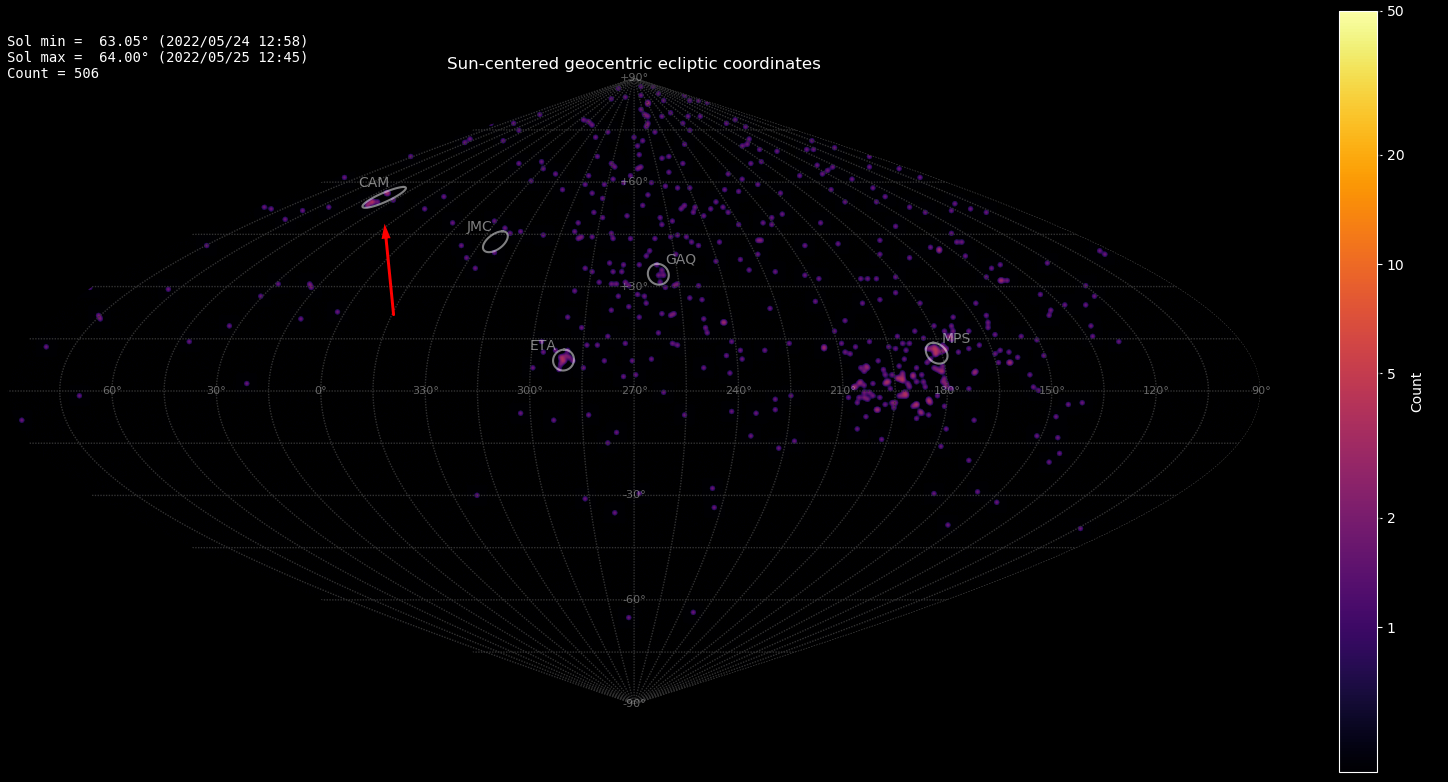
Figure 1 – The appearance of the Camelopardalid radiant based on orbits collected by the Global Meteor Network during the observing window 63.05° < λʘ < 64.00°.
Table 1 – The orbital elements of the 2022 Camelopardalids recorded between solar longitudes 63.415° and 63.685° and the mean orbit compared to results published in the literature.
| λʘ (°) |
R.A. (°) |
Dec. (°) |
vg km/s |
a AU |
q AU |
e | i (°) |
ω (°) |
Ω (°) |
Tj | N | Reference |
| 52.0 | 155.0 | +73.0 | 14.4 | 2.82 | 0.987 | 0.651 | 18.7 | 165 | 52 | 2.90 | 23 | Šegon et al., 2014 |
| 39.0 | 170.9 | +76.8 | 14.0 | 2.73 | 0.999 | 0.633 | 19.1 | 167.6 | 39.1 | 2.96 | 19 | Jenniskens & Nénon, 2016 |
| 40.6 | 182.7 | +83.2 | 13.0 | 2.07 | 1.000 | 0.517 | 19.0 | 167.9 | 40.6 | 3.53 | 4 | Kornoš et al., 2014 |
| 62.8 | 120.0 | +78.7 | 15.3 | 2.59 | 0.966 | 0.627 | 20.2 | 151.5 | 62.8 | 3.04 | 2014 Jenniskens et al., 2018 | |
| 62.9 | 119.7 | +79.8 | 15.6 | 2.58 | 0.965 | 0.626 | 20.9 | 151.4 | 62.9 | 3.04 | Jenniskens et al., 2018 | |
| 63 | 122.7 | +79.0 | 15.5 | 2.65 | 0.966 | 0.635 | 20.6 | 152.2 | 62.8 | 3.00 | 9 | 2014 outburst |
| 62.59 | 121.2 | +79.5 | 15.3 | 2.53 | 0.967 | 0.618 | 20.5 | 151.9 | 62.6 | 3.08 | 3 | Mean orbit 2019 |
| 65.69 | 120.6 | +73.9 | 15.8 | 2.93 | 0.904 | 0.691 | 19.35 | 150.3 | 65.69 | 2.80 | 209P/LINEAR | |
| 63.42 | 119.4 | +75.5 | 15.1 | 2.75 | 0.963 | 0.650 | 19.1 | 151.1 | 63.4 | 2.93 | – | 20220524_221115 |
| 63.46 | 112.0 | +76.7 | 14.6 | 2.34 | 0.958 | 0.591 | 19.0 | 148.8 | 63.5 | 3.24 | – | 20220524_231829 |
| 63.49 | 119.0 | +75.8 | 15.1 | 2.71 | 0.963 | 0.644 | 19.2 | 150.9 | 63.5 | 2.97 | – | 20220524_235946 |
| 63.55 | 124.2 | +78.5 | 14.9 | 2.45 | 0.968 | 0.605 | 19.8 | 152.0 | 63.6 | 3.15 | – | 20220525_013235 |
| 63.67 | 118.6 | +76.3 | 15.4 | 2.75 | 0.962 | 0.650 | 19.6 | 150.8 | 63.7 | 2.93 | – | 20220525_042550 |
| 63.67 | 119.9 | +76.4 | 15.7 | 2.93 | 0.963 | 0.671 | 19.9 | 151.2 | 63.7 | 2.82 | – | 20220525_042552 |
| 63.69 | 98.9 | +78.0 | 16.2 | 2.57 | 0.945 | 0.632 | 21.3 | 145.9 | 63.7 | 3.04 | – | 20220525_045610 |
| 63.56 | 116.0 | +76.7 | 15.3 | 2.63 | 0.960 | 0.634 | 19.7 | 150.1 | 63.6 | 3.01 | 7 | Mean orbit 2022 |
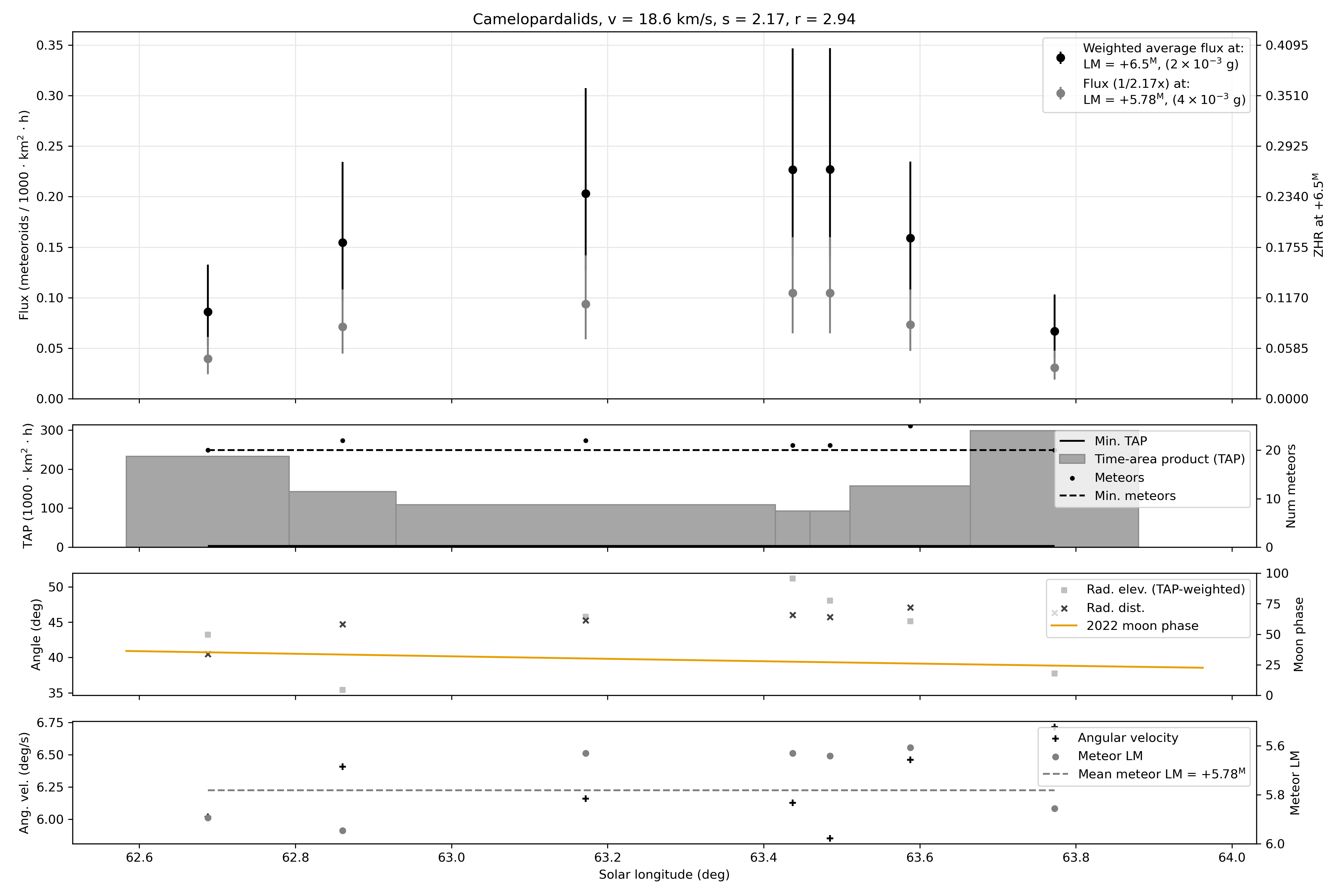
Figure 2 – The flux data obtained for the Camelopardalids recorded by the Global Meteor Network.
Activity enhancement in 2022
Like previous years the Global Meteor Network detected Camelopardalid orbits in May 2022 (Figure 1). Between solar longitudes 63.415° and 63.685°, corresponding to 2022 May 24, 22h and 2022 May 25, 05h UT, a remarkable activity enhancement with 7 Camelopardalid orbits has been recorded in this relative short time interval. The magnitudes ranged between –1.4 and +3.3. The time slot in which these orbits were recorded coincides with the ascending branch of the radio activity profile presented by Ogawa and Sugimoto (2022); The time of maximum for the radio observations occurred at λʘ = 63.71° (May 25, 5h33m UT), slightly before the theoretical predicted encounter at λʘ = 63.8° (2022 May 25, 8h UT). The activity level for radio observations was about half of the level recorded during the previous outburst in 2014, but much stronger than the activity level suggested by the 2022 GMN results. This discrepancy could indicate that the radio meteor activity consisted mainly of fainter meteors beyond the detectability of the optical system of the RMS cameras.
Computing the average and mean orbital elements using the method described by Jopek et al. (2006) all 7 orbits fit within a threshold of DSH < 0.075. Using this mean orbit to look at a wider observing window for orbits with DSH < 0.075, 14 similar orbits are found between May 18 and May 30. Using more tolerant D-criteria with DSH < 0.20 and DD < 0.08 (Drummond, 1981) we find as many as 150 similar orbits during the entire month of May 2022. It seems that the dust from comet 209P/LINEAR got dispersed to an extent that it takes Earth from end of April till begin of June to cross the dispersed meteoroid stream. The presence of relatively young dust trails such as observed in 2014, 2019 and 2022 should be distinguished from the dispersed annual component.
The individual orbits of the concentration of the Camelopardalid orbits and their mean orbit are listed in Table 1. The 2022 orbit data can be compared with some past data for this meteor shower.
Figure 2 shows the flux measurements of the activity enhancement. Due to the small number of events, the mass index could not be independently measured, so a previously measured value of s = 2.17 (Campbell-Brown et al., 2016) was used. The peak occurred at 63.45 ± 0.03° of solar longitude. A peak flux of 0.23 ± 0.1 × 10-3 meteoroids km2/h was measured at the limiting magnitude and mass of +6.5M and 2 × 10-3 g. The equivalent ZHR is 0.3 ± 0.1. This is about 130 times less than the activity derived from radio observations (Ogawa and Sugimoto, 2022), indicating that the stream is rich in small particles. Due to the low activity of the shower, most cameras either did not observe a single Camelopardalid, or only 1-2. However, such a small activity could be measured with confidence because flux observations from hundreds of meteor cameras were combined to produce a virtual global instrument, following the method described in Vida et al. (2022). Each time bin had a minimum time-area product of 100000 km2 h and 20 meteors.
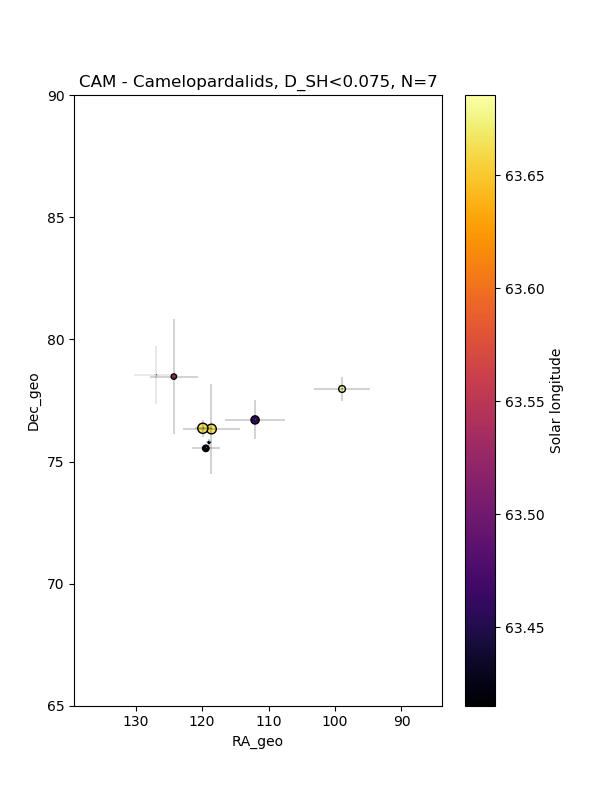
Figure 3 – The geocentric radiants in equatorial coordinates for the 7 Camelopardalid orbits.
The average duration of the 7 Camelopardalids was 1.3s, the beginning height Hb = 93.5 km and ending height He = 78.7 km. The height with maximum brightness occurred at Hpeak = 84.3 km, slightly lower than the 88 km found in 2014 by Jenniskens (2014). The average observational median fit error was 66.3”. Figure 3 shows the radiant points in geocentric equatorial coordinates and Figure 4 shows the radiants in Sun-centered geocentric ecliptical coordinates. The very compact radiant size in 2022 was also observed in 2014.
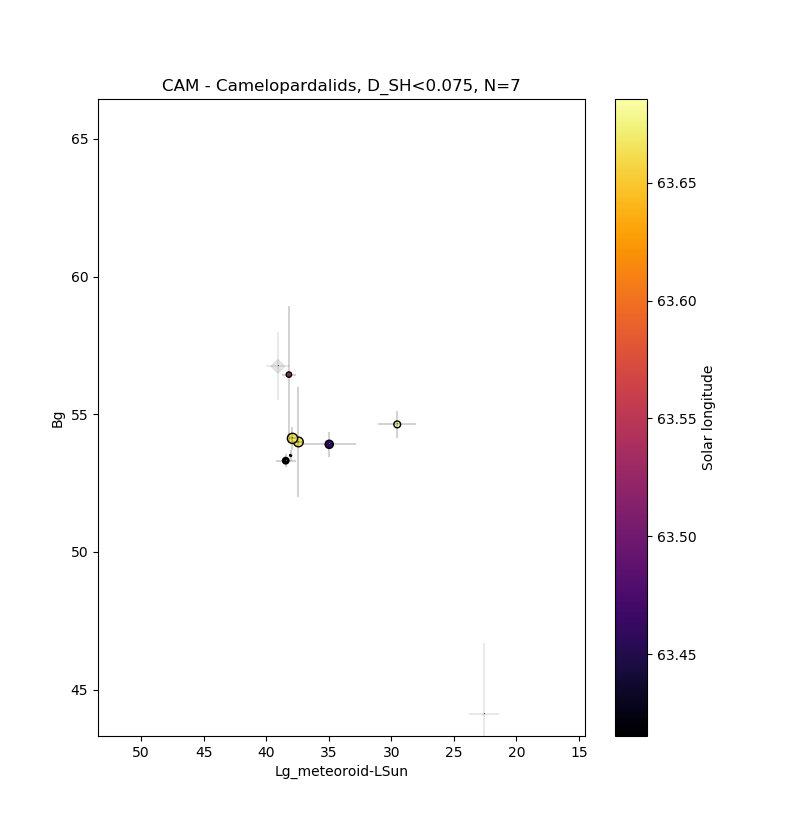
Figure 4 – The geocentric radiant in Sun-centered ecliptic coordinates for the 7 Camelopardalid orbits.
Conclusion
Camelopardalid orbits have been recorded in the past years indicating a large dispersion in time from end of April until beginning of June. This annual component could be recorded in 2022 with a peculiar small concentration of 7 very similar orbits that appeared around solar longitude 63.56° and which might be related to an unknown dust trail.
The orbit data collected so far during the past 15 years by different video camera networks may justify an in-depth analysis of this meteor shower in order to establish its activity period, radiant and orbital drift.
Acknowledgment
This report is based on the data of the Global Meteor Network which is released under the CC BY 4.0 license. The peculiar concentration of 7 very similar orbits has been recorded by GMN cameras in Belgium, Canada, Croatia, Germany, the United Kingdom and the US. A more detailed study will be possible thanks to the joined efforts of all GMN collaborators:
Richard Abraham, Victor Acciari, Rob Agar, David Akerman, Daknam Al-Ahmadi, Jamie Allen, Edison Álvarez José Felipe Pérezgómez, Alexandre Alves, Željko Andreić, Martyn Andrews, Miguel Angel Diaz, Enrique Arce, Georges Attard, Chris Baddiley, David Bailey, Erwin van Ballegoij, Roger Banks, Hamish Barker, Jean-Philippe Barrilliot, Richard Bassom, Ricky Bassom, Ehud Behar, Josip Belas, Alex Bell, Serge Bergeron, Denis Bergeron, Jorge Bermúdez Augusto Acosta, Steve Berry, Adrian Bigland, Chris Blake, Arie Blumenzweig, Ventsislav Bodakov, Claude Boivin, Robin Boivin, Bruno Bonicontro, Fabricio Borges, Ubiratan Borges, Dorian Božičević, David Brash, Ed Breuer, Martin Breukers, John W. Briggs, Peter G. Brown, Laurent Brunetto, Tim Burgess, Ludger Börgerding, Sylvain Cadieux, Peter Campbell-Burns, Andrew Campbell-Laing, Pablo Canedo, Seppe Canonaco, Jose Carballada, Steve Carter, David Castledine, Gilton Cavallini, Brian Chapman, Jason Charles, Matt Cheselka, Tim Claydon, Trevor Clifton, Manel Colldecarrera, Michael Cook, Bill Cooke, Christopher Coomber, Brendan Cooney, Edward Cooper, Jamie Cooper, Andrew Cooper, Marc Corretgé Gilart, Paul Cox, Llewellyn Cupido, Christopher Curtis, Ivica Ćiković, Dino Čaljkušić, Chris Dakin, Alfredo Dal’Ava Júnior, James Davenport, Richard Davis, Steve Dearden, Christophe Demeautis, Bart Dessoy, Paul Dickinson, Ivo Dijan, Pieter Dijkema, Tammo Jan Dijkema, Marcelo Domingues, Stacey Downton, Zoran Dragić, Iain Drea, Igor Duchaj, Jean-Paul Dumoulin, Garry Dymond, Jürgen Dörr, Robin Earl, Howard Edin, Ollie Eisman, Carl Elkins, Ian Graham Enting, Peter Eschman, Bob Evans, Andres Fernandez, Barry Findley, Rick Fischer, Richard Fleet, Jim Fordice, Jean Francois Larouche, Kyle Francis, Patrick Franks, Gustav Frisholm, Enrique Garcilazo Chávez, José García María, Mark Gatehouse, Ivan Gašparić, Chris George, Megan Gialluca, Kevin Gibbs-Wragge, Jason Gill, Philip Gladstone, Uwe Glässner, Hugo González, Nikola Gotovac, Neil Graham, Pete Graham, Colin Graham, Sam Green, Bob Greschke, Daniel J. Grinkevich, Larry Groom, Dominique Guiot, Tioga Gulon, Margareta Gumilar, Peter Gural, Nikolay Gusev, Kees Habraken, Alex Haislip, John Hale, Peter Hallett, Graeme Hanigan, Erwin Harkink, Ed Harman, Marián Harnádek, Ryan Harper, David Hatton, Tim Havens, Mark Haworth, Paul Haworth, Richard Hayler, Sam Hemmelgarn, Rick Hewett, Don Hladiuk, Alex Hodge, Simon Holbeche, Jeff Holmes, Nick Howarth, Matthew Howarth, Jeff Huddle, Bob Hufnagel, Roslina Hussain, Russell Jackson, Jean-Marie Jacquart, Jost Jahn, Phil James, Ron James Jr, Nick James, Rick James, Ilya Jankowsky, Alex Jeffery, Klaas Jobse, Richard Johnston, Dave Jones, Fernando Jordan, Vladimir Jovanović, Jocimar Justino de Souza, Javor Kac, Richard Kacerek, Milan Kalina, Jonathon Kambulow, Steve Kaufman, Paul Kavanagh, Alex Kichev, Harri Kiiskinen, Jean-Baptiste Kikwaya, Sebastian Klier, Dan Klinglesmith, John Kmetz, Zoran Knez, Korado Korlević, Stanislav Korotkiy, Danko Kočiš, Josip Krpan, Zbigniew Krzeminski, Patrik Kukić, Reinhard Kühn, Remi Lacasse, Gaétan Laflamme, Steve Lamb, Hervé Lamy, Jean Larouche Francois, Ian Lauwerys, David Leurquin, Gareth Lloyd, Rob Long De Corday, Eric Lopez, Jose Lopez Galindo, José Luis Martin, Juan Luis Muñoz, Pete Lynch, Frank Lyter, Anton Macan, Jonathan Mackey, John Maclean, Igor Macuka, Nawaz Mahomed, Simon Maidment, Mirjana Malarić, Nedeljko Mandić, Alain Marin, Bob Marshall, Colin Marshall, Andrei Marukhno, Keith Maslin, Nicola Masseroni, Bob Massey, Jacques Masson, Damir Matković, Filip Matković, Dougal Matthews, Michael Mazur, Sergio Mazzi, Stuart McAndrew, Alex McConahay, Robert McCoy, Charlie McCormack, Mark McIntyre, Peter Meadows, Edgar Merizio Mendes, Aleksandar Merlak, Filip Mezak, Pierre-Michael Micaletti, Greg Michael, Matej Mihelčić, Simon Minnican, Wullie Mitchell, Edson Morales Valencia, Nick Moskovitz, Dave Mowbray, Andrew Moyle, Gene Mroz, Muhammad Luqmanul Hakim Muharam, Brian Murphy, Carl Mustoe, Przemek Nagański, Jean-Louis Naudin, Damjan Nemarnik, Attila Nemes, Dave Newbury, Colin Nichols, Nick Norman, Philip Norton, Zoran Novak, Gareth Oakey, Washington Oliveira, Angélica Olmos López, Jamie Olver, Christine Ord, Nigel Owen, Michael O’Connell, Dylan O’Donnell, Thiago Paes, Carl Panter, Neil Papworth, Filip Parag, Gary Parker, Simon Parsons, Ian Pass, Igor Pavletić, Lovro Pavletić, Richard Payne, Pierre-Yves Pechart, William Perkin, Enrico Pettarin, Alan Pevec, Mark Phillips, Patrick Poitevin, Tim Polfliet, Pierre de Ponthière, Derek Poulton, Janusz Powazki, Aled Powell, Alex Pratt, Miguel Preciado, Chuck Pullen, Terry Pundiak, Lev Pustil’Nik, Dan Pye, Chris Ramsay, David Rankin, Steve Rau, Dustin Rego, Chris Reichelt, Danijel Reponj, Fernando Requena, Maciej Reszelsk, Ewan Richardson, Martin Richmond-Hardy, Mark Robbins, David Robinson, Martin Robinson, Heriton Rocha, Herve Roche, Adriana Roggemans, Paul Roggemans, Alex Roig, David Rollinson, Jim Rowe, Dmitrii Rychkov, Michel Saint-Laurent, Clive Sanders, Jason Sanders, Ivan Sardelić, Rob Saunders, John Savage, Lawrence Saville, Vasilii Savtchenko, William Schauff, Ansgar Schmidt, Jim Seargeant, Jay Shaffer, Steven Shanks, Mike Shaw, Angel Sierra, Ivo Silvestri, Ivica Skokić, Dave Smith, Tracey Snelus, Warley Souza, Mark Spink, Denis St-Gelais, James Stanley, Radim Stano, Laurie Stanton, Robert D. Steele, Yuri Stepanychev, Graham Stevens, Peter Stewart, William Stewart, Con Stoitsis, Andrea Storani, Andy Stott, David Strawford, Rajko Sušanj, Bela Szomi Kralj, Marko Šegon, Damir Šegon, Jeremy Taylor, Yakov Tchenak, Eric Toops, Torcuill Torrance, Steve Trone, Wenceslao Trujillo, John Tuckett, Myron Valenta, Jean Vallieres, Paraksh Vankawala, Neville Vann, Marco Verstraaten, Arie Verveer, Predrag Vukovic, Martin Walker, Aden Walker, Bill Wallace, John Waller, Jacques Walliang, Didier Walliang, Jacques Walliang, Christian Wanlin, Tom Warner, Neil Waters, Steve Welch, Alexander Wiedekind-Klein, John Wildridge, Ian Williams, Guy Williamson, Urs Wirthmueller, Bill Witte, Martin Woodward, Jonathan Wyatt, Anton Yanishevskiy, Penko Yordanov, Stephane Zanoni, Dario Zubović.
References
Campbell-Brown M.D., Blaauw R., Kingery A. (2016). “Optical fluxes and meteor properties of the Camelopardalid meteor shower”. Icarus, 277, 141–153.
Drummond J. D. (1981). “A test of comet and meteor shower associations”. Icarus, 45, 545–553.
Jenniskens P. (2006). Meteor Showers and their Parent Comets. Cambridge Univ. Press, Cambridge.
Jenniskens P, Lyytinen E. (2014). “Possible new meteor shower from comet 209P/LINEAR”. Central Bureau Electronic Telegrams, 3869.
Jenniskens P. (2014). “Camelopardalids (IAU#451) from comet 209P/LINEAR”. WGN, Journal of the International Meteor Organization, 42, 98–105.
Jenniskens P., Nénon Q. (2016). “CAMS verification of single-linked high-threshold D-criterion detected meteor showers”. Icarus, 266, 371–383.
Jenniskens P., Baggaley J., Crumpton I., Aldous P., Pokorny P., Janches D., Gural P. S., Samuels D., Albers J., Howell A., Johannink C., Breukers M., Odeh M., Moskovitz N., Collison J. and Ganjuag S. (2018). “A survey of southern hemisphere meteor showers”. Planetary Space Science, 154, 21–29.
Jopek T. J., Rudawska R. and Pretka-Ziomek H. (2006). “Calculation of the mean orbit of a meteoroid stream”. Monthly Notices of the Royal Astronomical Society, 371, 1367–1372.
Kornoš L., Matlovič P., Rudawska R., Tóth J., Hajduková M. J., Koukal J., and Piffl R. (2014). “Confirmation and characterization of IAU temporary meteor showers in EDMOND database”. In, Jopek T. J., Rietmeijer F. J. M., Watanabe J., and Williams I. P., editors, Meteoroids 2013, Proceedings of the Astronomical Conference held at A.M. University, Poznan, Poland, August 26–30, 2013, pages 225–233.
Madiedo J.M., Trigo-Rodríguez J.M., Zamorano J., Izquierdo J., Sánchez de Miguel A., Ocaña F., Ortiz J.L., Espartero F., Morillas L.G., Cardeñosa D., Moreno-Ibáñez M., Urzáiz M. (2014). “Orbits and emission spectra from the 2014 Camelopardalids”. Monthly Notices of the Royal Astronomical Society, 445, 3309–3314.
Ogawa H., Sugimoto H. (2022). “Meteor activity related to 209P/LINEAR by worldwide radio meteor observations”. eMetN, 7, xxx–xxx.
Roggemans P., Vida D., Šegon D. (2022). “Global Meteor Network report 2021”. eMetN, 7, 76–105.
Rudawska R., Jenniskens P. (2014). “New meteor showers identifiedin the CAMS and SonotaCo meteoroid orbit surveys”. In, Jopek T. J., Rietmeijer F. J. M., Watanabe J., and Williams I. P., editors, Meteoroids 2013, Proceedings of the Astronomical Conference held at A.M. University, Poznan, Poland, August 26–30, 2013, pages 217–224.
Šegon D., Gural P., Andreić Ž., Skokić I., Korlević K., Vida D., Novoselnik F. (2014). “New showers from parent body search across several video meteor databases”. WGN, Journal of the International Meteor Organization, 42, 57–64.
Southworth R. B. and Hawkins G. S. (1963). “Statistics of meteor streams”. Smithsonian Contributions to Astrophysics, 7, 261–285.
Tóth J., Kornoš L., Zigo P., Gajdoš Š., Kalmančok D., Világi J., Šimon J., Vereš P., Šilha J., Buček M., Galád A., Rusňák P., Hrábek P., Ďuriš F., Rudawska R. (2015). “All-sky Meteor Orbit System AMOS and preliminary analysis of three unusual meteor showers”. Planetary and Space Science, 118, 102–106.
Vida D., Eschman P. (2020). “2019 Camelopardalid (CAM#451) outburst as seen by Global Meteor Network stations in New Mexico”. eMetN, 5, 30–32.
Vida D., Blaauw Erskine R. C., Brown P. G., Kambulow J., Campbell-Brown M., Mazur M. J. (2022). “Computing optical meteor flux using Global Meteor Network data”. Monthly Notices of the Royal Astronomical Society, submitted.
Wiśniewski M., Żołądek P., and Tymiński Z. (2015). “Camelopardalids expedition”. In, Rault J.-L and Roggemans P., editors, Proceedings of the International Meteor Conference, Giron, France, 18-21 September 2014. International Meteor Organization, pages 82–84.
Ye Q, Wiegert P. A. (2014). “Will comet 209P/LINEAR generate the next meteor storm?”. Monthly Notices of the Royal Astronomical Society, 437, 3283–3287.

